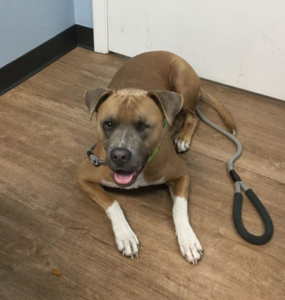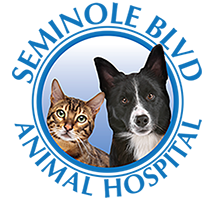How to Curb Your Pet’s Fear: Carl’s Story
 Meet our client Carl, a one and a half-year-old Pit bull mix who visited Seminole Blvd. Animal Hospital, after several traumatic visits at other veterinary offices for his wellness exam and vaccines. When Carl would visit the vet, it was common for him to become so afraid his fight or flight senses would kick in, and he would become aggressive.
Meet our client Carl, a one and a half-year-old Pit bull mix who visited Seminole Blvd. Animal Hospital, after several traumatic visits at other veterinary offices for his wellness exam and vaccines. When Carl would visit the vet, it was common for him to become so afraid his fight or flight senses would kick in, and he would become aggressive.
Understanding Carl’s background with vet visits the team at SBAH knew what Carl needed to have a happy and successful wellness checkup. Dr. Clark prescribed Trazodone, an anti-anxiety medication that takes the edge off for those experiencing fear aggression allowing the pet to remain alert and lucid but more relaxed without becoming “knocked out”. Carl is given this medication at home 2-3 hours before the pet’s appointment at the clinic.
In addition to the medication, SBAH utilizes some fear-free tactics when Carl comes to visit the clinic. We often have the same veterinary technician with him at every visit, and this leads to a more comfortable environment with Carl someone new each time. Lots of treats are essential. However, some pets are too nervous to take treats so we use peanut butter plates and lots of cookies. We will schedule his appointment to be the first thing in the morning or shortly after lunch. Upon Carl’s arrival at the clinic, we take him straight into the exam room and give the first round of treats. When it comes time for Dr. Clark to do his exam, he will go slow and at Carl’s pace. At the end of the visit, we schedule a Happy Visit for next time! A “Happy Visit” is when Carl stops by to say hello. We do not do an exam at these visits, they are designed to take the fear out of the visit we give him treats, pets, and head rubs. No restraint or vaccinations, blood draws of any kind.
What is Fear Aggression in Dog?
Fear aggression typically involves defensive behavior based on fear. When a dog enters a stressful situation and begins to growl, bark, or show his teeth to make the scary object go away, that is a sign of fear aggression. If this behavior works, it will send a message that responding this way a frightening thing it gets them out of a situation. It is important to note that there is not a recipe for fear aggression, every pet is different, and their ability to handle stress follows suit. As a pet owner, it is crucial for you to recognize what is causing your dog’s anxiety or distress; these signs may include:
• Subtle tensing of their muscles
• Excessive panting
• Head-turning away from a fearful situation
• Freezing
• Biting the leash
• Whining
• Growling
If you observe any signs of fear or stress aggression, protect your dog by increasing your distance from the scary situation, please call or send a text (727) 587-0200 to set up an appointment to discuss the best option for your pet.
